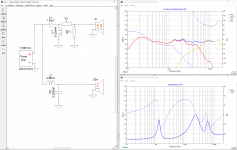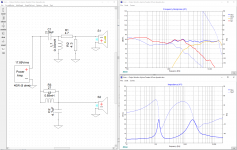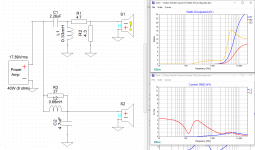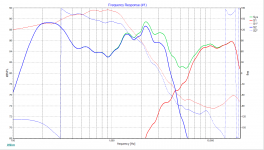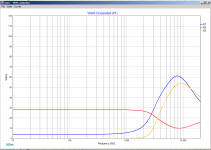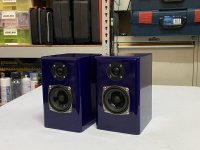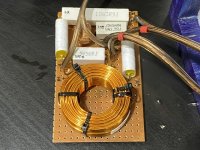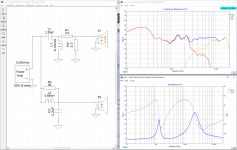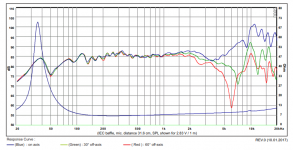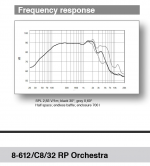Should the tweeter be crossed that high? Can you get the midrange response to tilt downward or level rather than rise again?
Indeed you can't do lower frequency measurements the normal way in a room. However even for higher frequencies it is best to 'gate' them, after putting them away from nearby surfaces.
You shouldn't need to find acoustic centres unless you cannot get proper timed measurements. This piece of knowledge is not so well known it would seem.
I'd say similar about finding a null. Not necessary if you have a simulator that shows phase. Besides, it only shows you whether the drivers are in phase, not how well they sum as part of the system.
How's that for a start 🙂
If the measurements you have done have the relative phase built in, then you actually need to make sure the sim software has NO offsets entered.
Also I believe with Xsim, when importing the frd, there are different options, one of which extracts I think the minimum phase.
The methods I have used are to take all measurements on the tweeter axis. If using holmimpulse after doing the tweeter measurement, finding time zero, and then locking it, so that all other measurements are relative to that.
Dear Allen and Tony, thank you for your kind responses, which really made me think and revisit the design. I attached the old circuit and the new one with R3 added, as well as Ampere and Watt simulation for 40W (8Ohm) amp.
I re-imported the frd into XSim without adding delay to the woofer, but using "derived" option and checking the "show orig. phase" box. I also tried to tame the highs of the midrange to tilt downward, by adding a parallel resistor to the inductor. This managed to do that, at the same time flattened the frequency response around 2-3kHz and smoothed the impedance nicely 😉😉
This brings the crossover frequency down to 3.2kHz from previously 5.4kHz.
AND..the graph shows "correct" response with the tweeter's polarity reversed, as is expected with 2nd order filters.
What do you think guys, am I on to something here? 🙂🙂
Another thing, I would really love to have the crossover inside the box, so component size is important to me. Kindly take a look at the power draw graph, do I really need to use 20W resistors for this, or can I get away with smaller ones? Thank you so much!!
Attachments
Last edited:
Thanks Allen, it does help to see the changes of response with each change of component value. 🙂
On the question of resistor wattage, I assume you are talking mostly about R1. IMO no. The cap is limiting the dissipation to high frequency range, and it is highly unlikely you will have that kind of power in those frequency ranges. I think a 10W resistor would be fine. R3 I'm not so sure about.
BUT I would need to check whether xsim power calcs are based on peak or expected average power dissapation. I'm basing the above comments on the assumption it is peak...
Tony.
BUT I would need to check whether xsim power calcs are based on peak or expected average power dissapation. I'm basing the above comments on the assumption it is peak...
Tony.
A simulator should show full amplifier output per frequency. Of course this is completely un-realistic, but it is not Xsim's job to guess how you'll use the speaker 😉
Jonathan, that woofer response is not easy to work with, do you think it is realistic? Most woofers would peak at their top end, which is higher than 2kHz for a 3" driver. I don't want to put too much on your plate at once, but I'm aware that you'll have a hard time trying to flatten that curve, and it would be a shame adding a bandstop filter to treat a phantom measured reflection.
Jonathan, that woofer response is not easy to work with, do you think it is realistic? Most woofers would peak at their top end, which is higher than 2kHz for a 3" driver. I don't want to put too much on your plate at once, but I'm aware that you'll have a hard time trying to flatten that curve, and it would be a shame adding a bandstop filter to treat a phantom measured reflection.
OK I always like to verify with some real world experience. Below is a plot out of X-Sim as to what the power dissipation in the lpad on my tweeter would be at 100W input power (the speaker is being driver by a 100W amplifier).
Now note that this lpad I placed before the crossover, without thinking about the fact that, that meant it was actually working over the entire frequency range up to the crossover frequency, not just on what passes through the crosover, so the R2 shunt resistor (22 ohms) is passing for all of the bass as well, and just putting additional strain on the amp.
What was actually implemented were 12W resistors and even running at high volumes for an extended period of time they don't even get warm.
The other thing to think about is that most tweeters are rated at around 10 - 15W RMS (but tend to be rated with suitable crossover, often for around the 100W mark. the XSIM graph shows the tweeter running at around 55W which would cook most tweeters if not just a transient.
Tony.
Now note that this lpad I placed before the crossover, without thinking about the fact that, that meant it was actually working over the entire frequency range up to the crossover frequency, not just on what passes through the crosover, so the R2 shunt resistor (22 ohms) is passing for all of the bass as well, and just putting additional strain on the amp.
What was actually implemented were 12W resistors and even running at high volumes for an extended period of time they don't even get warm.
The other thing to think about is that most tweeters are rated at around 10 - 15W RMS (but tend to be rated with suitable crossover, often for around the 100W mark. the XSIM graph shows the tweeter running at around 55W which would cook most tweeters if not just a transient.
Tony.
Attachments
Hi Tony and Allen, thank you so very much for all your kind help. I’ve finished the project. I’ve decided to go ahead and built it, and actually have a listen. Boy am I happy I did. It sounds really good, considering the drivers, the size, and my limited knowledge on speaker building. I attach the final schematic as built, the final crossover layout, and the finished pair. I added 5 grams of dacron behind the midwoofer magnet.
Thank you again guys, this thread has been very very educational for me.
Thank you again guys, this thread has been very very educational for me.
Attachments
2-way or not 2-way? (That is actually the question)
I was planning to build 3-way speakers. I chose the Eton Orchestra 8-612 for the woofer and SB Acoustics SB15NBAC30-8 for the mids. I haven't decided on the tweeters yet.
I am now debating with myself whether to go 3-way due to the flat frequency response of the Etons up to 2khz. Does having the midrange add anything? Will the Eton perform better if it has a narrower bandwidth to cover? I'd really like some opinions on this. Thanks!

I was planning to build 3-way speakers. I chose the Eton Orchestra 8-612 for the woofer and SB Acoustics SB15NBAC30-8 for the mids. I haven't decided on the tweeters yet.
I am now debating with myself whether to go 3-way due to the flat frequency response of the Etons up to 2khz. Does having the midrange add anything? Will the Eton perform better if it has a narrower bandwidth to cover? I'd really like some opinions on this. Thanks!

It may just work but consider the problem.. the 8" is beginning to narrow at 2kHz. Flat response or not you might notice it reduces apparent output in that range. Some people like the sound of an 8" and modern tweeter, maybe it's because the 8" seems to give a more solid lower midrange in a typical application. On the other hand you don't actually need an 8" to achieve this.
Some might use a larger tweeter to reach the 8" a bit below 2kHz, and that's not a bad choice if you can find one to play well at the top. But this is the catch.. most tweeters are designed to get to 20kHz. Most midrange choices are based on crossing one of those tweeters as low as you reasonably can. This usually puts them at 6.5", or 5".
One option is to combine this with a larger woofer crossed low (which should be relatively easy to do), and experiment with baffle sizes to give the sound you want. This way you only have one cross in the midrange.. and while a lower cross is not a bad thing, there are limits.
Some might use a larger tweeter to reach the 8" a bit below 2kHz, and that's not a bad choice if you can find one to play well at the top. But this is the catch.. most tweeters are designed to get to 20kHz. Most midrange choices are based on crossing one of those tweeters as low as you reasonably can. This usually puts them at 6.5", or 5".
One option is to combine this with a larger woofer crossed low (which should be relatively easy to do), and experiment with baffle sizes to give the sound you want. This way you only have one cross in the midrange.. and while a lower cross is not a bad thing, there are limits.
Attachments
AllenB said:..the 8" is beginning to narrow at 2kHz. Flat response or not you might notice it reduces apparent output in that range.
Sir,
I once crossed off an 8" woofer to a 90* horn at 2kHz. However, I chose to do that since the datasheet said that its effective piston diameter was only 6.5", although physical dimensions were 8". Is that OK from the beaming point of view? I don't have any means for spatial measurements of the said design.
Thanks.
Yes, it's a reasonable guess.
Using the above plots as a generic example, the point would be just above 2kHz although I notice it seems to occur with breakup. This can mean partially that it varies from driver to driver.
Using the above plots as a generic example, the point would be just above 2kHz although I notice it seems to occur with breakup. This can mean partially that it varies from driver to driver.
Are you sure that the frequency repsonse of the 8" Eton is what you posted? Looking at the datasheet it is quite different to your image link. When I saw the image I thought that can't be an 8" driver...
Attached is from the datasheet for the driver model you mentioned, note that the graphic you linked to had a different driver which appears to be a 4" Eton, which would explain why it didn't look like an 8".
I think you would have trouble mating this with a tweeter directly unless it is some sort of compession driver that can be crossover over very low.
The datasheet does say recommended freq range 40 - 2000Hz, but I'm sceptical 🙂 You could have some baffle step related hump in the 1 - 2Khz range (depending on your baffle) and if combined with the existing response humpthat this driver exhibits (on infinite baffle) you will likely end up with problems.
Tony.
Attached is from the datasheet for the driver model you mentioned, note that the graphic you linked to had a different driver which appears to be a 4" Eton, which would explain why it didn't look like an 8".
I think you would have trouble mating this with a tweeter directly unless it is some sort of compession driver that can be crossover over very low.
The datasheet does say recommended freq range 40 - 2000Hz, but I'm sceptical 🙂 You could have some baffle step related hump in the 1 - 2Khz range (depending on your baffle) and if combined with the existing response humpthat this driver exhibits (on infinite baffle) you will likely end up with problems.
Tony.
Attachments
This can mean partially that it varies from driver to driver.
Could you please tell me where mine (E8-150S, attached) stands? It has a paper cone and cloth surround. Thanks.
View attachment E8-150S Old Model.pdf
its effective piston diameter was only 6.5", although physical dimensions were 8".
That is pretty typical, drivers are typically ranked by basket size (which can cause confusion if the vasket is big).
dave
Fun w/ LspCad 6
Ok, been working with LspCad for quite a while off & on, since the early days of Lspcad 5, where it was very useful for box & tuning simulation. I will be contacting Ingemar about this, but for now wondered if anyone here has had "issues" with importing driver measurement data into LspCad. The program changes the data - either adds up to 10dB or more, even with all the boundary simulation effects turned off or deleted. What is troubling is the effect is not simple scaling either. What is displayed in the program is not what is in the data file. Kinda making it difficult to progress with any design.
Keep in mind I am fully aware of boundary effects, baffle gain, and diffraction, all of which LspCad is designed to simulate. However these can be a controlled add to the design sim, if not then I have no idea what I have in a design.
Ok, been working with LspCad for quite a while off & on, since the early days of Lspcad 5, where it was very useful for box & tuning simulation. I will be contacting Ingemar about this, but for now wondered if anyone here has had "issues" with importing driver measurement data into LspCad. The program changes the data - either adds up to 10dB or more, even with all the boundary simulation effects turned off or deleted. What is troubling is the effect is not simple scaling either. What is displayed in the program is not what is in the data file. Kinda making it difficult to progress with any design.
Keep in mind I am fully aware of boundary effects, baffle gain, and diffraction, all of which LspCad is designed to simulate. However these can be a controlled add to the design sim, if not then I have no idea what I have in a design.
I'm not familiar with it but this would be a frustrating situation. Clearly you are aware of what must be done in order to establish a baseline.
I used LspCad5 a long time ago. I wanted to explore the optimiser function. It was neat in some tricky situations but mostly I didn't use it.
I moved to Speaker Workshop at some point and despite its clunky interface, at the time I recall it was easy to establish a baseline. It did have some shortcomings (only from the point of view of where I wanted to go with it) but no problem because I could do the extra work manually and re-enter it and continue.
I used LspCad5 a long time ago. I wanted to explore the optimiser function. It was neat in some tricky situations but mostly I didn't use it.
I moved to Speaker Workshop at some point and despite its clunky interface, at the time I recall it was easy to establish a baseline. It did have some shortcomings (only from the point of view of where I wanted to go with it) but no problem because I could do the extra work manually and re-enter it and continue.
I've always liked a dedicated midrange - way more upper midrange clarity IMO 🙂I was planning to build 3-way speakers. I chose the Eton Orchestra 8-612 for the woofer and SB Acoustics SB15NBAC30-8 for the mids. I haven't decided on the tweeters yet.
I am now debating with myself whether to go 3-way due to the flat frequency response of the Etons up to 2khz. Does having the midrange add anything? Will the Eton perform better if it has a narrower bandwidth to cover? I'd really like some opinions on this. Thanks!
Maybe look at the Seas DXT. It's cheap and smooth, and suits a 5" well around 2kHz. I'm really loving it right not together with a Dayton RS125 as midrange between 500-2kHz.
- Home
- Loudspeakers
- Multi-Way
- Design your own speaker from scratch discussion thread
